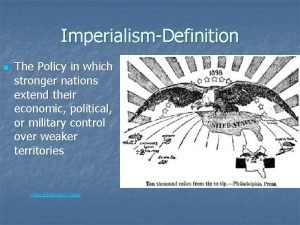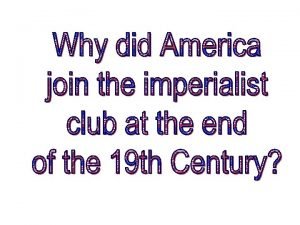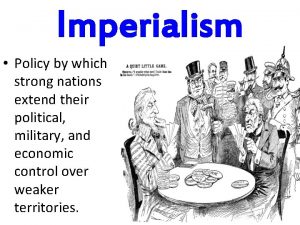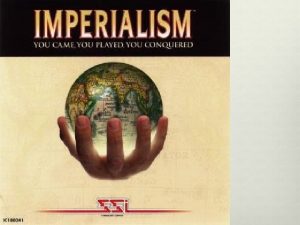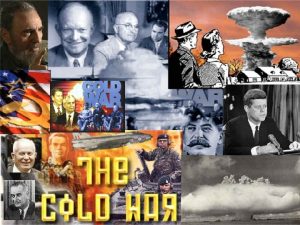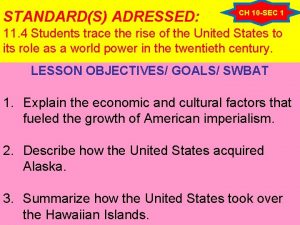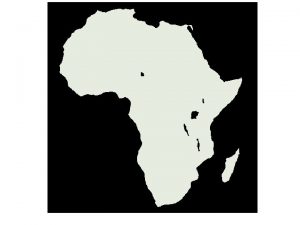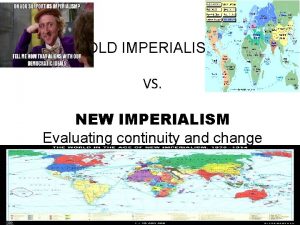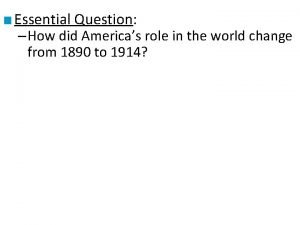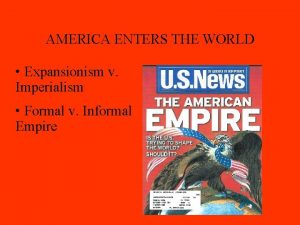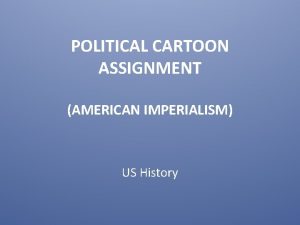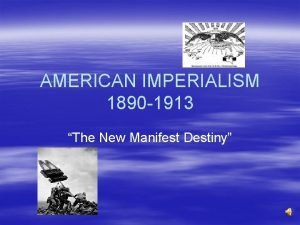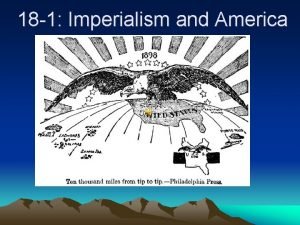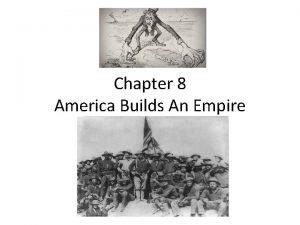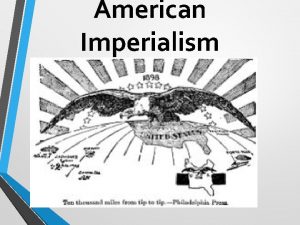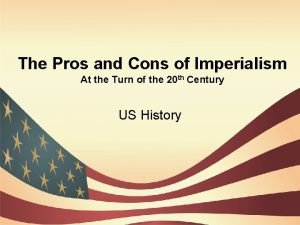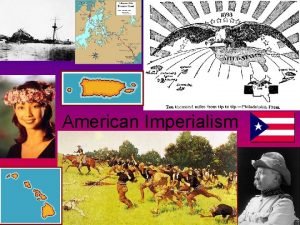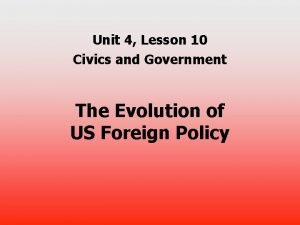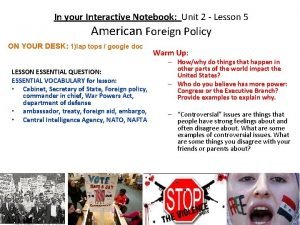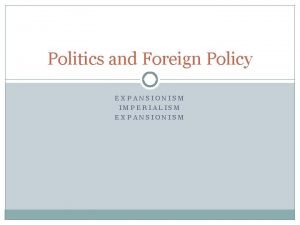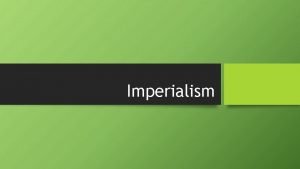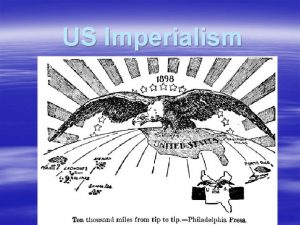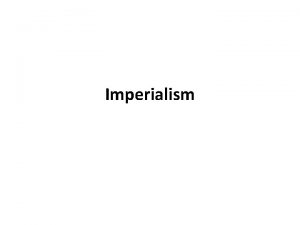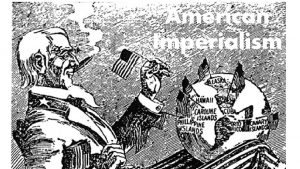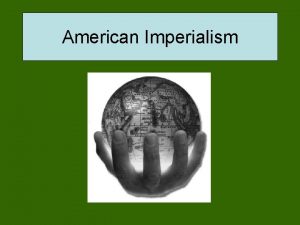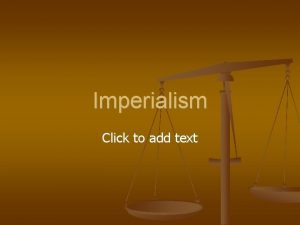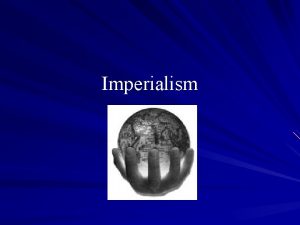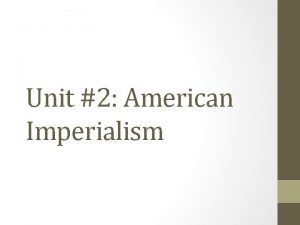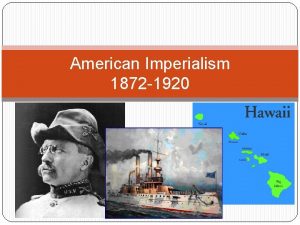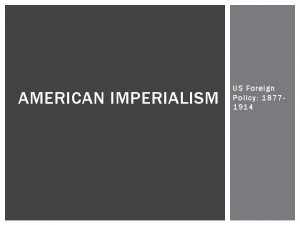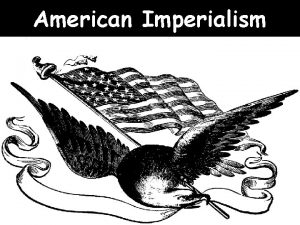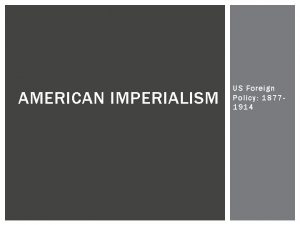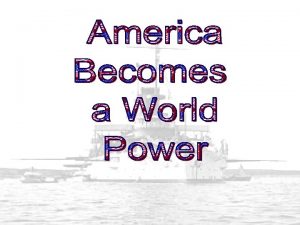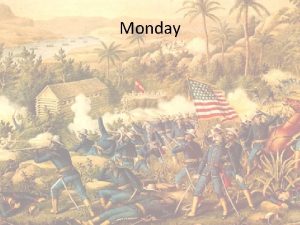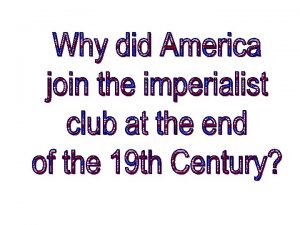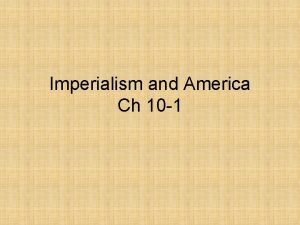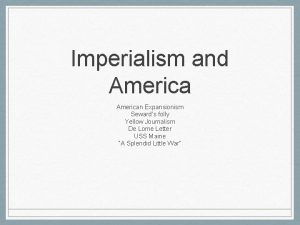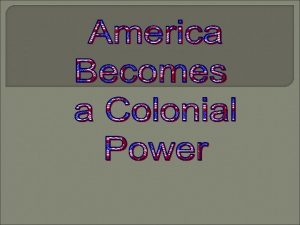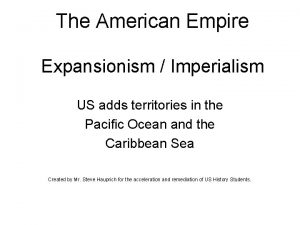American Expansionism Imperialism a policy where stronger nations























- Slides: 23


American Expansionism Imperialism: a policy where stronger nations extend their economic, political or military control over weaker territories or nations. By the late 1880 s, many American leaders felt convinced that America should join the imperialist powers of Europe in establishing colonies over seas in a world trend of imperialism.

Global Competition In the late 19 th century, large nations began to consume smaller or less powerful nations making both Africa and China targets of European, American and Japanese expansion efforts. It took some time for Americans to be okay with the idea of expanding over seas.

3 Factors that fueled Imperialism 1. Desire for Military Strength: As other nations began to establish a strong military presence. The U. S. built up its own military strength in effort to compete with other powerful nations. 2. Thirst for New Markets: Advances in American technology allowed American farms and factories to produce more goods than Americans could consume. This new need for raw materials and a place to sell the overproduced finished goods, fueled the growth and need foreign trading partners and suppliers.

3. Belief in Cultural Superiority: Cultural factors were sometimes used to explain imperialism. Here the idea of Social Darwinism along with a belief in the superiority of Anglo-Saxons lead to a push to “civilize” the world’s “inferior peoples” through the spreading of Christianity. Understand that the terms “civilize” and “inferior peoples” were defined only by one perspective.

Acquisition of Alaska Under the direction of William Seward, the United States purchased Alaska from the Russians in 1867 for $7. 2 million --- roughly about 2 cents an acre. Passing the treaty to purchase this parcel of land was more challenging than he had expected though it was rich in timber, minerals and later oil. Alaska became a state in 1959.

The United States Takes Hawaii Prior to Hawaii becoming a state, the United States has a clear presence in the Hawaiian Islands specifically in the sugar plantations. After taxation (tariffs) were placed back on sugar exportation, American sugar planters urged the U. S. to annex the islands in effort to eliminate the tax that the farmers were having to pay. Annexation: The formal act of acquiring something (especially a territory) by conquest or occupation.

Understanding the value of the Islands was easy for Am. military and economic leaders as they had pressured the officials of Hawaii to allow the U. S. to build a naval base at Pearl Harbor to serve as a refueling station for American ships. After a transfer of power in Hawaii, the Queen was overthrown and replaced. As president Cleveland got involved he made it clear that he was unwilling to annex Hawaii unless a majority of Hawaiians favored it.

On August 12, 1898, Congress made Hawaii an American territory though never providing Hawaiians with an opportunity to vote. In 1959, Hawaii became the 50 th state.

Acquiring New Lands In the early 1900’s the United States took part in conflicts with Puerto Rico, Cuba and the Philippines… Purpose of today’s notes to learn what those conflicts entailed.

Puerto Rico Not all Puerto Ricans wanted independence: Some wanted statehood Some wanted to become an American territory. Puerto Rico was very important to the U. S. It maintained a presence in the Caribbean Protected interests in a future canal across the Isthmus of Panama.

P. R. Continued As a result of the Spanish American War, Puerto Rico (as well as Guam, Cuba and the Philippines) was given to the U. S. In 1900, Congress passed the Foraker Act: Ended military rule in P. R. setting up a civil government instead. allowed special privileges for the U. S. govt. In 1901, the U. S. Supreme Court decided the Insular Cases, stating that the Constitution did not automatically apply to people in acquired territories.

The Beginnings with Cuba The relationship with Spain was anything but easy. When Mc. Kinley took office the demands for American intervention in Cuba were on the rise. After a letter was taken from the Post office leaking the weaknesses of the U. S. President in negotiations with Cuba, the American people became angry. The explosion of the U. S. S. Maine led to more tension between the U. S. and Spanish leading to the start of the Spanish American War – Remember the Maine!

Cuba After the war with Spain, Cuba was occupied by American troops. America’s interest was once again in sugar. Cubans who protested American involvement were imprisoned or exiled (why would we imprison them? ) In 1900, under a newly formed government, Cuba wrote a constitution for their independent nation.

Cuba Continued In 1901, the U. S. insisted that Cuba add several provisions known as the Platt Amendment to their constitution, refusing to withdraw until they were added: Cuba could not make treaties that would limit its independence The U. S. reserved the right to intervene in Cuba was not to go into debt that its govt could not repay The U. S. could buy or lease land on the island for Naval Purposes.

Cuba Continued 2 In 1903, the Platt Amendment became part of a treaty between the two nations, and Cuba became a U. S. protectorate – (a nation whose affairs are partially controlled by a stronger power). America needed a strong political presence in Cuba due to business interests in sugar, tobacco, mining & railroads.

Philippines At first the Filipino people were willing to work with the U. S. in taking out the Spanish (in their desire for independence). However once the War ended the partnership also ended. The Filipinos rebelled when they learned that America was granted permission to annex the islands. Lead by Emilio Aguinaldo, Filipinos revolted against the U. S. using guerilla tactics. The United States implemented practices that Spain had used in Cuba, forcing Filipinos to live in designated zones where hunger, poor sanitation and disease killed thousands.

Philippines Cont. It took three years and over $400 million to put down the rebellion – (that is 20 times the cost of the islands). After the war, a govt similar to Puerto Rico was set up. The U. S. believed that the conquering of the Philippines was a gateway to Asia.

Influence in China was seen as a huge market for American goods. Weakened by war and foreign involvement China was often referred to as the Sick Man of Asia. Fearing that China may be split into trade colonies, John Hay published a series of policy statements “Open Door Notes, ” proposing that nations share their trading rights with the U. S. , thus creating an “open door. ”

China Continued Although China maintained its freedom, Europeans dominate most of China’s large cities. This fueled resentment and eventually the Boxer Rebellion (where members of a secret Chinese society sought to free their nation from western influence). After the victory over the Boxer Rebellion, the U. S. feared that European nations would take more control over China, which encouraged the second series of Open Door Notes.

Understanding the Open Door Notes The Open Door Policy illustrated three deeply held American beliefs about the U. S. : 1. Americans believed that the growth of the U. S. economy depended on exports. 2. Americans felt that the U. S. had a right to intervene abroad to keep foreign markets open. 3. Americans feared that the closing of an area to American products, citizens or ideas would threaten U. S. survival.

3 Factors that fueled imperialism 1. Desire for Military Strength: 2. Thirst for New Markets 3. Belief in cultural superiority

 The policy in which stronger nations
The policy in which stronger nations The policy in which stronger nations
The policy in which stronger nations De lome letter definition us history
De lome letter definition us history Queen liliuokalani
Queen liliuokalani Imperialism and industrialization
Imperialism and industrialization Cold war
Cold war What 3 factors spurred american imperialism?
What 3 factors spurred american imperialism? The iron curtain
The iron curtain Old imperialism vs new imperialism
Old imperialism vs new imperialism Old imperialism technology
Old imperialism technology Foreign policy imperialism
Foreign policy imperialism Foreign policy imperialism
Foreign policy imperialism What three factors spurred american imperialism
What three factors spurred american imperialism Cartoon
Cartoon American imperialism definition
American imperialism definition Roots of american imperialism
Roots of american imperialism Economic roots of american imperialism
Economic roots of american imperialism Chapter 8 america builds an empire
Chapter 8 america builds an empire American imperialism 1800s
American imperialism 1800s Pros and cons of imperialism
Pros and cons of imperialism American imperialism political cartoons explained
American imperialism political cartoons explained Alaska american imperialism
Alaska american imperialism Unit 4 lesson 10 american foreign policy
Unit 4 lesson 10 american foreign policy Lesson 5: american foreign policy
Lesson 5: american foreign policy
